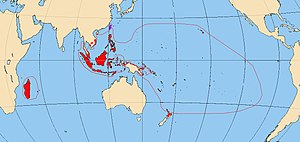
Back Austronesiese tale Afrikaans Austronesische Sprachen ALS Notimolan kalokanatal a finacadan AMI لغات أسترونيزية Arabic Llingües austronesies AST Avstroneziya dilləri Azerbaijani آوسترونزییا دیللری AZB Soroh Basa Austronésia BAN Mga tataramon na Austronesyo BCL Аўстранезійскія мовы Byelorussian
| Austronesian | |
|---|---|
| Geographic distribution | Taiwan, Maritime Southeast Asia, Madagascar, parts of Mainland Southeast Asia, Hainan (China), and Oceania |
| Ethnicity | Austronesian peoples |
| Linguistic classification | One of the world's primary language families |
| Proto-language | Proto-Austronesian |
| Subdivisions | |
| Language codes | |
| ISO 639-2 / 5 | map |
| Glottolog | aust1307 |
 The historical distribution of Austronesian languages | |
The Austronesian languages (/ˌɔːstrəˈniːʒən/ AW-strə-NEE-zhən) are a language family widely spoken throughout Maritime Southeast Asia, parts of Mainland Southeast Asia, Madagascar, the islands of the Pacific Ocean and Taiwan (by Taiwanese indigenous peoples).[1] They are spoken by about 328 million people (4.4% of the world population).[2][3] This makes it the fifth-largest language family by number of speakers. Major Austronesian languages include Malay (around 250–270 million in Indonesia alone in its own literary standard named "Indonesian"),[4] Javanese, Sundanese, Tagalog (standardized as Filipino[5]), Malagasy and Cebuano. According to some estimates, the family contains 1,257 languages, which is the second most of any language family.[6]
In 1706, the Dutch scholar Adriaan Reland first observed similarities between the languages spoken in the Malay Archipelago and by peoples on islands in the Pacific Ocean.[7] In the 19th century, researchers (e.g. Wilhelm von Humboldt, Herman van der Tuuk) started to apply the comparative method to the Austronesian languages. The first extensive study on the history of the phonology was made by the German linguist Otto Dempwolff.[8] It included a reconstruction of the Proto-Austronesian lexicon. The term Austronesian was coined (as German austronesisch) by Wilhelm Schmidt, deriving it from Latin auster "south" and Ancient Greek νῆσος (nêsos "island").[9]
Most Austronesian languages are spoken by island dwellers. Only a few languages, such as Malay and the Chamic languages, are indigenous to mainland Asia. Many Austronesian languages have very few speakers, but the major Austronesian languages are spoken by tens of millions of people. For example, Indonesian is spoken by around 197.7 million people. This makes it the eleventh most-spoken language in the world. Approximately twenty Austronesian languages are official in their respective countries (see the list of major and official Austronesian languages).
By the number of languages they include, Austronesian and Niger–Congo are the two largest language families in the world. They each contain roughly one-fifth of the world's languages. The geographical span of Austronesian was the largest of any language family in the first half of the second millennium CE, before the spread of Indo-European in the colonial period. It ranged from Madagascar off the southeastern coast of Africa to Easter Island in the eastern Pacific. Hawaiian, Rapa Nui, Māori, and Malagasy (spoken on Madagascar) are the geographic outliers.
According to Robert Blust (1999), Austronesian is divided into several primary branches, all but one of which are found exclusively in Taiwan. The Formosan languages of Taiwan are grouped into as many as nine first-order subgroups of Austronesian. All Austronesian languages spoken outside the Taiwan mainland (including its offshore Yami language) belong to the Malayo-Polynesian (sometimes called Extra-Formosan) branch.
Most Austronesian languages lack a long history of written attestation. This makes reconstructing earlier stages—up to distant Proto-Austronesian—all the more remarkable. The oldest inscription in the Cham language, the Đông Yên Châu inscription dated to c. 350 AD, is the first attestation of any Austronesian language.
- ^ Blust, Robert Andrew. "Austronesian Languages". Encyclopædia Britannica. Retrieved 26 October 2016.
- ^ "Statistical Summaries; Ethnologue".
- ^ "Austronesian; Ethnologue".
- ^ Sneddon, James Neil (2004). The Indonesian Language: Its History and Role in Modern Society. UNSW Press. p. 14.)
- ^ Gonzalez, Andrew B. (1980). Language and Nationalism: The Philippine Experience Thus Far. Manila: Ateneo de Manila University Press. p. 76. ISBN 9711130009.
- ^ Robert Blust (2016). History of the Austronesian Languages. University of Hawaii at Manoa.
- ^ Pereltsvaig (2018), p. 143.
- ^ Dempwolff, Otto. Vergleichende Lautlehre des austronesischen Wortschatzes [Comparative phonology of the Austronesian vocabularies] (3 vols). Beihefte zur Zeitschrift für Eingeborenen-Sprachen (Supplements to the Journal of Native Languages) 15; 17; 19 (in German). Berlin: Dietrich Reimer.
- ^ John Simpson; Edmund Weiner, eds. (1989). Official Oxford English Dictionary (OED2) (Dictionary). Oxford University Press.